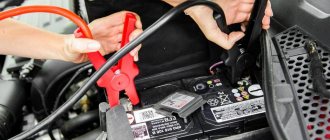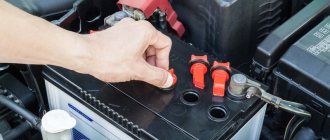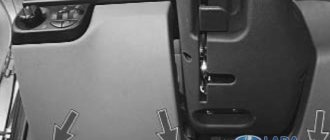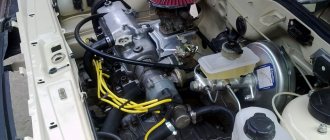From time to time, even maintenance-free and expensive battery models have to be connected to a mains charger. Such an operation cannot be avoided when the car has been sitting in a garage for a long time or has been operated at low engine speeds.
Regardless of the cause of the discharge, many motorists try to replenish electricity without disconnecting the battery from the vehicle’s on-board network. Whether such an operation can be carried out safely and why many vehicle owners use this method will be discussed in detail below.
Is it possible to charge a battery without removing the terminals?
Rechargeable batteries have been used in cars for over 100 years. During this time, car owners became convinced from personal experience that it is possible to charge the battery without disconnecting it from the on-board electrical system.
Many motorists claim that restoring charge using this method is completely safe, but some drivers have encountered serious problems with the car’s electrical equipment.
Is such charging possible?
The ability to charge batteries from a network charger without disconnecting from the vehicle's power supply system is not surprising. Almost all electrical appliances of this type are equipped with crocodile clips, which can be easily connected over the terminals.
It is enough to connect the device correctly (observing the polarity), turn on the device to a 220 V network, and the charging process will be carried out in standard mode. To increase the efficiency of the charger, you must turn off the ignition.
Even not very powerful electronic devices operating during the charging process can significantly increase the period of time required to completely restore the battery.
Unfortunately, devices such as radios and alarms are constantly connected to the car’s on-board network, so completely disabling them can cause significant difficulties.
You will have to put up with such a “standby” load, despite the presence of a significant increase in the time for battery recovery. Otherwise, you will need to disconnect one or both terminals from the battery.
Why you shouldn’t charge like this and what is the danger
As mentioned above, when the charger is connected to the battery without disconnecting the terminals, current from the electrical appliance can flow to electricity consumers operating in standby mode.
If the output voltage of the charging device does not exceed 14.7 Volts, then you should not be afraid for the safety of the equipment. Some chargers can generate voltages significantly higher than this value, which can cause damage to devices that work in the car all the time.
The presence of constantly switched on devices will significantly increase the load on the memory, which is also an undesirable point. For the same reason, the duration of battery charge restoration will increase, so if it is necessary to carry out this operation with minimal time, it is better to disconnect the battery from the vehicle’s on-board system.
Using an auxiliary battery
Auto electricians recommend using the following method when dismantling the battery, which prevents the car’s electronics from being reset:
- take a 12-volt battery with a sufficient charge level that can support the car’s electronics;
- Using special wires, connect this battery in parallel to the car terminals;
- disconnect the main battery.
In the absence of the main battery, the vehicle's electronics will be “powered” by an auxiliary energy source. After charging the main battery, it can be returned back into the electrical circuit without any problems. This method is complicated by the fact that not every car owner has a spare battery and wires for connecting an auxiliary battery.
Why drivers don't like to disconnect the battery from the network
Many drivers do not like to disconnect the battery from the network. There may be several reasons for this decision:
- Laziness.
- If you turn off the power to the vehicle's on-board system, the settings in many devices that are not equipped with a backup power source can be completely reset. For example, the time in a radio may be lost if the battery installed on the board of this device can no longer cope with autonomously supplying the device with electricity.
- Many drivers are in no hurry to disconnect the terminals again due to possible breakdowns of these elements. According to statistics, when removing and connecting connecting elements, failure of parts occurs much more often than when charging the battery without removing it from the car.
- Disconnecting and reconnecting the terminals may result in insufficient electrical contact. In such a situation, an electric arc may form, which will melt the battery leads and terminals. Many drivers, precisely because of the possible failure of the connecting elements, try to charge the battery connected to the on-board system of the car.
The listed reasons for the reluctance to disconnect the battery are quite convincing, therefore, even despite the possible risks, car owners try to restore the battery charge using this method.
How long does it take to charge properly?
The duration of the charge directly depends on the condition and capacity of the battery, as well as the recovery method used. The latter means the use of direct, alternating current and an accelerated algorithm. In most cases, motorists charge the battery for 5-15 minutes, replenishing its capacity directly while driving. But if it is necessary to completely restore the charge, then on average a device of 50-60 Ah takes from 12 to 16 hours.
In most cases, motorists charge the battery within 5-15 minutes
In what case is charging with terminals allowed?
In all cases where the potential danger from disconnecting the terminals from the battery is greater than the likelihood of damage to the equipment from connecting the charger without performing this procedure, it is recommended to connect the DC source without removing the connecting elements from the battery.
If, after disconnecting the terminals from the battery, their further use is impossible, then it is also more advisable to connect charging without disconnecting the wires from the battery.
For example, if there are cracks in the connecting element, such an operation can lead to destruction of the metal. In the absence of spare parts, such a breakdown may lead to the fact that it will no longer be possible to start the engine and, accordingly, operation of the machine will be impossible.
How to charge a battery without removing the terminals
If you decide not to remove the battery from the car and charge the battery without disconnecting the terminals, then this work should be completed without errors. First of all, you need to turn off the ignition, because a working dashboard, ignition system and other devices will consume a significant amount of electricity.
Next, connect the charger. The device should be de-energized if it was previously turned on. Then you need to determine where the positive terminal of the battery is. A red clamp should be connected to it. Accordingly, the black “crocodile” should be connected to the negative terminal of the battery.
At the next stage, the charger is connected to a 220 Volt network. If no errors were made, then immediately after activating the charging mode, the voltage of the required values will begin to be supplied to the battery terminals.
If an automatic device is used, no further action is required. When connecting a device with the ability to adjust the current, it is recommended to set the value of this parameter equal to 10% of the battery capacity.
To remove terminals or not
Now we should consider in more detail the question of whether it is possible in practice to charge the battery without removing the terminals.
If possible, use an alternative charging method that will not reset the settings.
To do this, you will need a spare 12 Volt battery. The meaning of the procedure is as follows:
- take a spare battery with a good charge level;
- using the wires from the kit, a parallel connection is made to the terminals of the standard battery;
- the main battery is turned off;
- At the same time, power continues to be supplied to on-board consumers, but from the spare battery.
The only problem is that many people simply don’t have a spare battery.
Therefore, the question of whether it is necessary to remove both terminals in a car when charging a standard battery is more relevant. By connecting an external charger without disconnecting the battery, you increase the risk of exceeding the permissible limited voltage in the vehicle's on-board electrical network. But the sensors on modern cars are designed for voltage surges of a maximum of 15.7 V. And this is less than the parameters of external charges. There are also chargers that can briefly produce 17.5-18 V. Therefore, before connecting, it is worth checking the peak performance of the charger with a tester.
If there is an old calcium battery under the hood, when restoring the charge, a voltage of 16-17 V must be supplied to it. Thus, if you do not remove the terminals, you can easily damage the electronics of the car, since the maximum permissible load here is 14.5 V.
In modern calcium batteries, this problem has been eliminated due to special alloys and elements that reduce the supplied voltage to safe values.
There are different scenarios depending on the specific vehicle and charging conditions. There are several situations to consider here.
- Carburetor engine. The first option is if the carburetor is under the hood. In this case, the question of whether it is necessary to remove both terminals when charging a car battery is not particularly pressing. If we talk about domestic cars, the electronic unit responsible for the voltage in the generator circuit is the same on all cars. By connecting an external charging unit, you should not expect any negative effects. If these are imported carburetor cars, where a special electronic controller was provided, then here you will have to act by analogy with injection cars.
- Injectors. Another question is if the injector provides for battery recharging. Here is the answer to the question of whether it will be possible to charge the battery without removing the terminals from it. Such engines with distributed injection have a microprocessor unit that controls the supply of the air-fuel mixture, focusing on various sensors. The generator is equipped with a rectifier unit and a voltage regulator with high precision power settings for the on-board circuit. The controller has protective solutions that do not allow supplying power with high voltage. But you cannot rely solely on the operation of the fuses. There is a risk that a sharp voltage surge will occur if you connect the charger without disconnecting the terminals. You shouldn't do that. On injectors, it is usually better to remove the battery and charge it separately from the car. Here it is worth reading the manufacturer's manual. There are situations when removing the battery is not even recommended.
- Running motor. Another situation involves charging with the engine running. By starting the engine, the generator turns on. He signs the battery and charges it. If you apply additional voltage using a charger, you could potentially damage the components of the generator itself. The ECU is unlikely to be damaged. But it is prohibited to charge the battery when the internal combustion engine is running.
- Contamination on terminals. Carefully examine the condition of the components. If you see dirty terminals and oxides, it is not recommended to charge the battery. First you need to get rid of all contaminants.
Precautionary measures
When working with electric current, safety comes first. For this reason, it is prohibited to perform this operation in a damp room. Failure to comply with this requirement may result in electric shock or damage to the charger.
Modern battery charging devices are well protected from polarity reversal. If the terminals are connected incorrectly, the fuse will blow, but the main circuit should remain unaffected.
It is not recommended to check the functionality of the safety elements, so you should be careful when connecting the wires coming from the charger to the battery.
All electrical contacts must be in perfect working order. The presence of sparks in the immediate vicinity of flammable substances can result in a fire.
Still have questions or have something to add? Then write to us about it in the comments, this will make the material more useful, complete and accurate.











